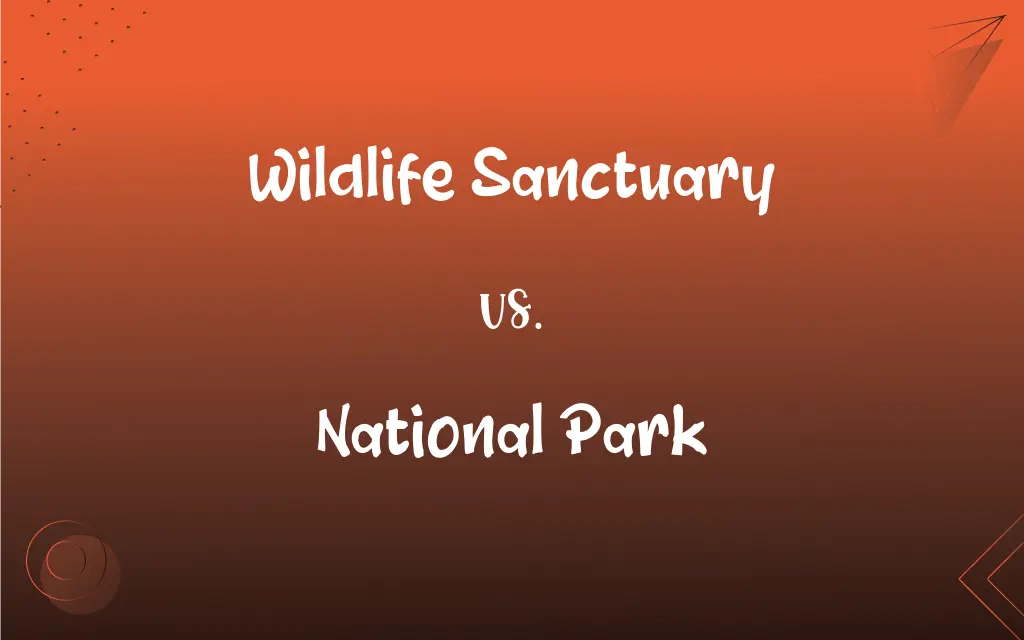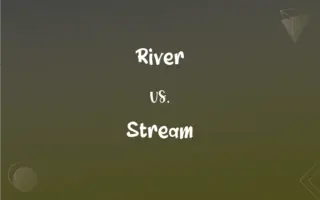Wildlife Sanctuary vs. National Park: What's the Difference?
Edited by Janet White || By Harlon Moss || Updated on October 20, 2023
Wildlife sanctuary primarily protects specific species of flora and fauna; national park conserves entire ecosystems and landscapes.

Key Differences
A wildlife sanctuary is a designated area where the primary focus is to protect specific species of wildlife from any external threats. The emphasis is on the conservation of certain species that might be endangered or rare. On the other hand, a national park is an expansive protected area set aside by a country's government. Its primary aim is to safeguard the natural environment, which includes landscapes, ecosystems, wildlife, and recreational areas.
In a wildlife sanctuary, human activities might be restricted, particularly those that pose a threat to the specific wildlife it shelters. In contrast, national parks are often more accommodating of human recreation and tourism, while still ensuring that the natural habitats within are conserved and managed sustainably.
When it comes to regulation and administration, wildlife sanctuaries often have stricter guidelines regarding human interference with the flora and fauna. Conversely, while national parks do focus on conservation, they also aim to provide educational, aesthetic, cultural, and recreational values to visitors.
Both wildlife sanctuaries and national parks play crucial roles in biodiversity conservation. A wildlife sanctuary mainly serves as a refuge for specific species, ensuring they have a safe and nurturing environment. Meanwhile, a national park's broader approach benefits entire ecosystems, allowing all interconnected species and their habitats to thrive together.
Comparison Chart
Primary Focus
Protects specific species
Conserves entire ecosystems and landscapes
ADVERTISEMENT
Human Activities
Highly restricted, especially if harmful to species
Regulated, but more accommodating of recreation
Tourism and Access
Limited, based on the species' needs
Often encouraged with educational and recreational facilities
Administration
Stricter guidelines on interference with species
Balance between conservation and visitor experience
Size and Scope
Can vary, often smaller focused on species habitats
Larger, covering diverse habitats and ecosystems
Wildlife Sanctuary and National Park Definitions
Wildlife Sanctuary
A protected area for specific species.
The bald eagle thrives in this wildlife sanctuary.
ADVERTISEMENT
National Park
A government-regulated expanse of diverse habitats.
The national park is home to both mountain ranges and dense forests.
Wildlife Sanctuary
A zone restricting harmful human activities.
Hunting is strictly prohibited within the wildlife sanctuary.
National Park
A protected area preserving natural landscapes.
Yellowstone is a renowned national park in the US.
Wildlife Sanctuary
A haven for biodiversity conservation.
Numerous bird species flock to the wildlife sanctuary during migration.
National Park
A zone for both conservation and recreation.
Tourists camp and hike in the national park during summer.
Wildlife Sanctuary
A refuge for endangered or threatened fauna.
Tigers are being rehabilitated in the wildlife sanctuary.
National Park
A haven for various ecosystems and their wildlife.
The coral reefs in the national park are teeming with marine life.
Wildlife Sanctuary
A designated area governed by strict regulations.
Before entering the wildlife sanctuary, visitors must obtain special permits.
National Park
An area offering educational and aesthetic experiences.
Schools often organize trips to the national park for environmental education.
FAQs
Can I camp in a wildlife sanctuary?
Generally, no. Wildlife sanctuaries have stricter restrictions on human activities.
What is the primary purpose of a wildlife sanctuary?
To protect and conserve specific species of flora and fauna.
How does a national park differ from a wildlife sanctuary in terms of size?
National parks are usually larger, encompassing diverse habitats, while wildlife sanctuaries might be smaller, focusing on specific species' habitats.
Why are some species confined to wildlife sanctuaries?
To provide them a safe environment, especially if they are endangered or threatened.
Are pets allowed in wildlife sanctuaries?
Usually, pets are not allowed to ensure the safety and well-being of the wildlife.
Can wildlife sanctuaries be privately owned?
Yes, some sanctuaries are privately owned but still adhere to conservation principles.
Can I fish in a national park?
It depends on the park's regulations, but many national parks allow regulated fishing.
What's the difference in biodiversity between a wildlife sanctuary and a national park?
Wildlife sanctuaries focus on specific species, while national parks conserve a broader range of ecosystems and their biodiversity.
How do national parks contribute to education?
They offer programs, guided tours, and exhibits to educate visitors about nature and conservation.
Are there international standards for national parks?
While there's no single global standard, many countries adopt guidelines from bodies like the IUCN.
How are national parks funded?
They are often funded by government allocations, entrance fees, and sometimes donations.
Do national parks have accommodations for visitors?
Many do, ranging from campgrounds to lodges and visitor centers.
Are there age restrictions for entering a national park?
Generally, no, but some activities within the park may have age limits.
Is research conducted in wildlife sanctuaries?
Yes, many sanctuaries facilitate research to understand and protect species better.
Can I volunteer at a wildlife sanctuary?
Yes, many wildlife sanctuaries welcome volunteers to support their conservation efforts.
What threats do wildlife sanctuaries protect against?
Poaching, habitat destruction, human interference, and sometimes natural predators.
Do both wildlife sanctuaries and national parks charge entry fees?
It varies. Some do charge fees, while others might offer free entry.
Do national parks allow hunting?
Typically, no. Hunting is prohibited in national parks to conserve wildlife.
Can businesses operate within wildlife sanctuaries?
Typically, no. The focus is on conservation without commercial interference.
Are vehicles allowed inside national parks?
In most cases, yes, but there may be designated areas and paths for vehicles.
About Author
Written by
Harlon MossHarlon is a seasoned quality moderator and accomplished content writer for Difference Wiki. An alumnus of the prestigious University of California, he earned his degree in Computer Science. Leveraging his academic background, Harlon brings a meticulous and informed perspective to his work, ensuring content accuracy and excellence.
Edited by
Janet WhiteJanet White has been an esteemed writer and blogger for Difference Wiki. Holding a Master's degree in Science and Medical Journalism from the prestigious Boston University, she has consistently demonstrated her expertise and passion for her field. When she's not immersed in her work, Janet relishes her time exercising, delving into a good book, and cherishing moments with friends and family.































































